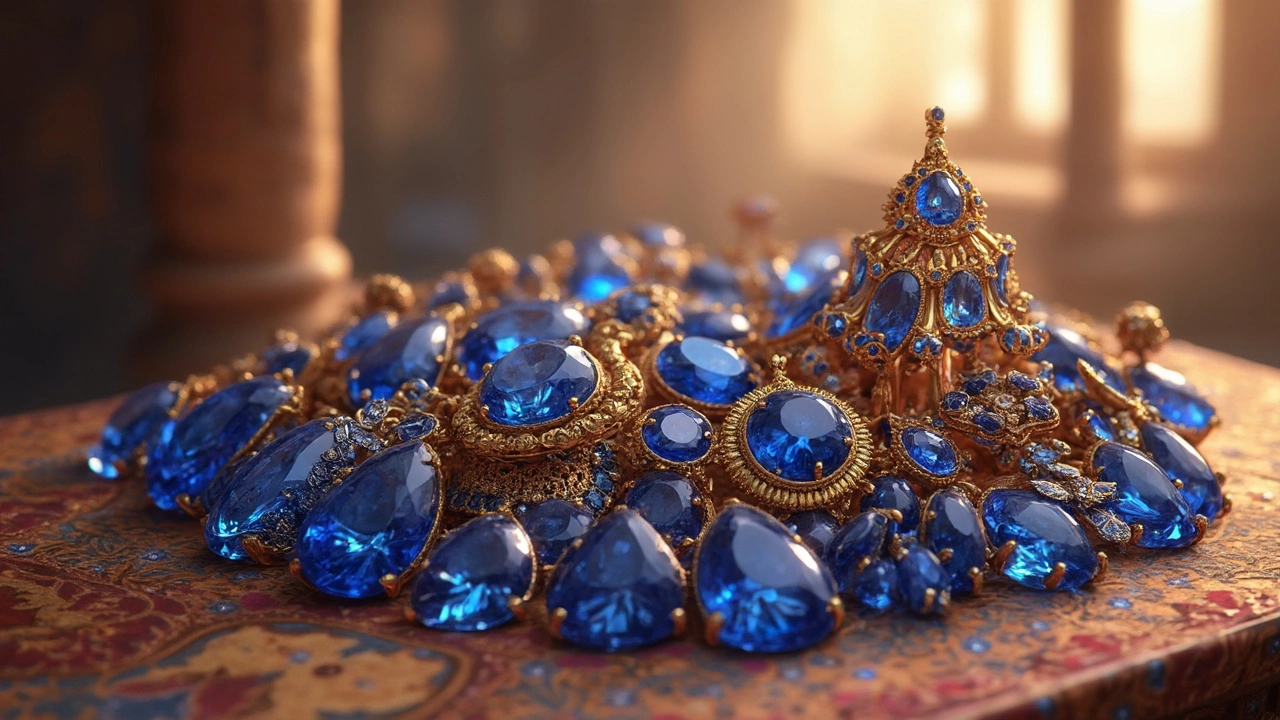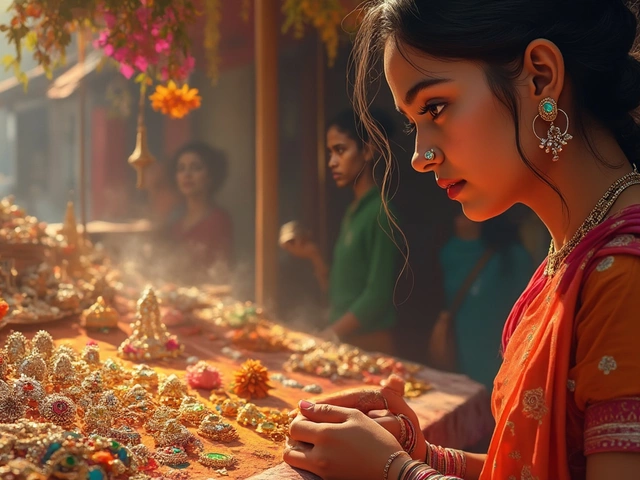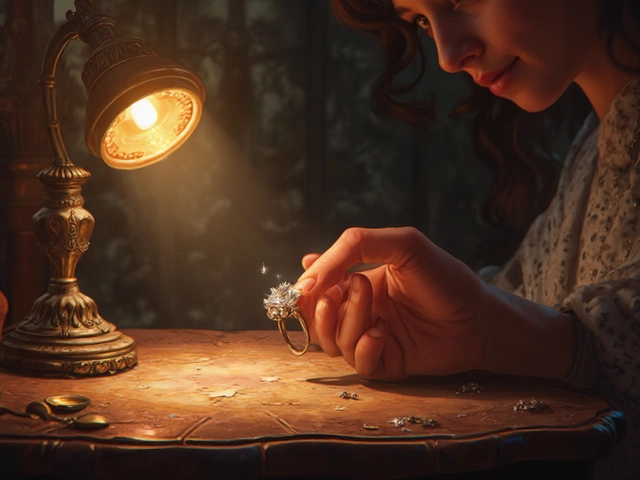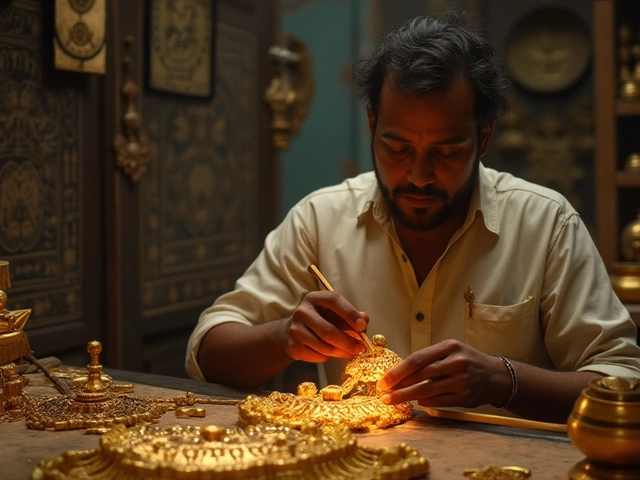So, you're eyeing that deep blue beauty, wondering if it's got the Kashmir touch. Kashmir sapphires are like the rock stars of the gem world, celebrated for their dreamy color and rarity. Knowing what sets them apart can be your ticket to spotting a real gem.
The first thing to look for? That special cornflower blue color with a velvety texture. It feels almost magical, you know? These bad boys originate from the Kashmir region in the Himalayas, which only adds to their mystique and desirability.
But before you start planning a trip to the mountains or diving into temple jewellery shopping sprees, you'll need some tips for checking authenticity. Uncovering the true identity of these gems can be easier with some inside knowledge, saving you from buying just another pretty blue rock.
- The Magic of Kashmir Sapphires
- Distinct Characteristics
- Why They Shine in Temple Jewellery
- Verifying Authenticity
- The Significance in Indian Craftsmanship
- Tips for Collectors and Enthusiasts
The Magic of Kashmir Sapphires
Alright, let’s talk about why Kashmir sapphires are so special. Picture this: a gem with a blue so rich, it’s compared to the cornflower. Not just any blue, but a mesmerizing, velvety glow that captures light in the most flattering way. This isn’t your everyday sapphire; these gems hail from a specific region in the mystical Himalayas.
Back in the 1880s, these sapphires were discovered in the Zanskar range of the Himalayas, known as the Padder valley. Amid rugged terrains and chilly winds, miners unearthed these gems with their unmistakable glow. This small area produced Kashmir sapphires during a short, seven-year period of intense mining, which adds a kind of mythical backstory to the stone.
Why do we care so much? Well, it’s this rare blend of color, quality, and the history of where they come from. The supply was never huge, meaning each stone is like a rare artifact. And here's the thing: they’re unmatched in terms of saturation and luminosity. That’s why they’re the stars of temple jewellery, often seen in intricate Indian designs that require the best of the best.
These gems are more than just pretty rocks; they’re a piece of history and artistry that makes them a must-have for serious gemstone collectors. So, next time you see that velvet-like blue shine, you’ll know you might just be looking at a genuine Kashmir sapphire, a slice of earth’s beauty and history wrapped up in a single stone.
Distinct Characteristics
Okay, so let's break down what makes a Kashmir sapphire so special. First off, it's all about the color. These gems have a unique blue hue often described as "cornflower blue." It's not just a simple blue but a soft, velvety shade that seems to glow from within, especially under natural light.
One cool thing about these gems is the silky quality of their appearance. This happens due to tiny needle-like inclusions called rutile that diffuse light, creating a sort of 'velvety' effect. Unlike blemishes in other gems, these inclusions are a hallmark of authenticity.
Here's another trick to spot an authentic Kashmir sapphire: they often have a strong saturation with less tone. In simpler terms, they hold onto their vivid color intensely without appearing too dark or too light.
- Origin Story: These gems come from the high-altitude regions of Kashmir, mined between 1880 and 1920.
- Size and Cut: Kashmir sapphires are often cut into cushion or oval shapes, maximizing their sparkle.
- Impact of Location: The unique geological conditions of the Kashmir region contribute to their radiant color and rarity.
With the continued scarcity due to their original mines being exhausted, owning a Kashmir sapphire is like holding a piece of history. If you're seeking these gems for temple jewellery or any special piece, knowing these characteristics is your best bet for finding the real deal.
Why They Shine in Temple Jewellery
Throughout history, gemstones have always been a big deal in temple jewellery, especially in India. But when it comes to a Kashmir sapphire, things hit a whole new level. These gems aren't just about looking pretty; they carry deep symbolic meanings and cultural significance that fit perfectly into the spiritual world.
A Kashmir sapphire is believed to channel spiritual energy, which makes it an ideal choice for adorning deities in temples. The unique velvety blue shade is often associated with wisdom and royalty—qualities that matter a lot in the chiseled stories of many artifacts you find in temples.
Why do these gems rule the temple jewellery scene? They're connected to legends and traditions. People say that a piece of jewellery with a Kashmir sapphire could bestow blessings and bring prosperity. They've been traditionally used in India for ages, signifying more than just wealth—think divine resonance and spiritual energy.
Plus, the uniqueness factor is incredible. Genuine Kashmir sapphires are rare, giving that one-of-a-kind vibe that matches the exclusivity temples aim for in their jewellery collections.
Let's talk practicality for a moment. While many stones come in all shapes and strengths, Kashmir sapphires are hard enough to withstand the test of time, staying flawless through various rituals and celebrations. That durability makes them perfect candidates for temple settings where they need to gleam year after year.
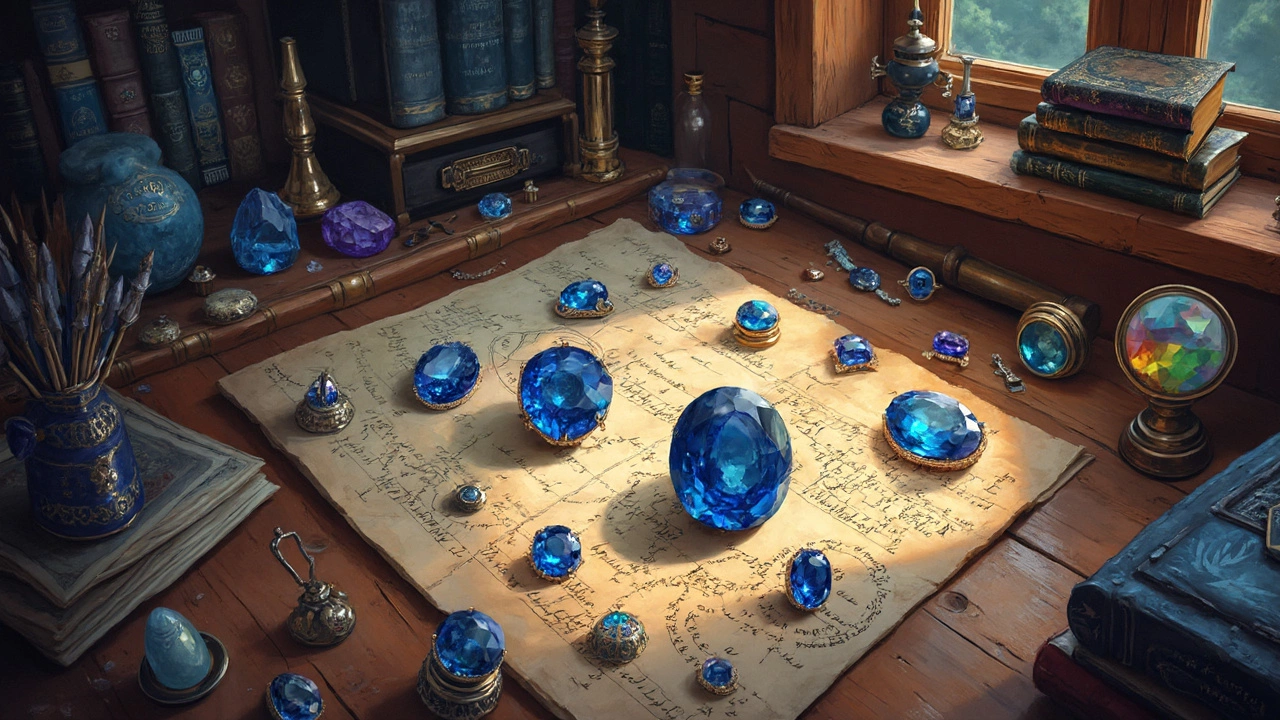
Verifying Authenticity
You’ve got your eyes on what looks like a genuine Kashmir sapphire, but how can you be sure it’s not just another pretty blue stone? It's all about knowing the telltale signs and using some reliable tips to spot the real deal. Let’s break it down so you're not left second-guessing your purchase.
The first thing you want to do is examine the gem's color. A true Kashmir sapphire sports a rich, cornflower blue hue with a velvety look, something no other sapphire quite matches. Hold it under different lighting—natural daylight is your best friend here—to see if the color holds its unique charm.
Next, consider sourcing a gemological report. Reliable reports from trusted organizations like GIA (Gemological Institute of America) or IGI (International Gemological Institute) can confirm if your sapphire hails from Kashmir. These reports document origin, color, and quality, serving as your gem’s authenticity passport.
| Testing Organization | What They Check | Benefits |
|---|---|---|
| GIA | Origin, Color Saturation | Highly Reliable, Detailed Report |
| IGI | Clarity, Cut Details | Extensive Analysis, Global Recognition |
If you’re hands-on, use a magnifying glass to search for inclusions. Kashmir sapphires may have tiny inclusions that imitate the appearance of silk, contributing to that velvety texture. These inclusions are naturally present from their unique formation process in the Himalayan mountains.
Lastly, knowing the source or history of the gemstone can help. Reputable jewellers or collectors with a well-documented provenance on their temple jewellery pieces can provide insights into the gemstone's origins.
Always remember, when in doubt, consult a certified gemologist. They can perform advanced tests, like spectroscopy or chromatography, that go beyond what the eye can see, ensuring you're investing in a legitimate piece of gemstone history.
The Significance in Indian Craftsmanship
In the world of temple jewellery, Kashmir sapphires hold a special place, and it's not just for their stunning beauty. These gems are symbols of prestige and are highly prized in Indian crafts. Their deep blue hue pairs beautifully with traditional designs, adding an element of luxury and splendor to the intricate work.
Historically, these sapphires were a favorite among royalty, often adorning the crowns and ornaments of kings and queens. This royal connection still resonates today, making Kashmir sapphires an enduring symbol of status and luxury in temple jewellery collections. They fit perfectly within the elaborate patterns that carry spiritual significance, often seen in earrings, necklaces, and bracelets dedicated to deities.
Indian artisans, known for their meticulous craftsmanship, appreciate the unique qualities of these gems. The velvety texture of a true Kashmir sapphire complements gold and silver settings, creating a mesmerizing contrast that highlights the fine details of traditional Indian jewellery. The craftsmanship is meant to honor both the divine and the gem itself, making each piece a creative expression that tells a story.
The art of crafting temple jewellery with Kashmir sapphires requires skill and an understanding of the gem's character. Craftsmen have developed techniques to work with these stones, ensuring they're set in a way that fully displays their natural beauty. This includes carefully selecting and cutting the sapphires to maximize their brilliance and color, a task that demands precision and an eye for detail.
Collectors and enthusiasts often seek out these pieces not only for their beauty but also for their cultural significance. Temple jewellery featuring Kashmir sapphires is considered an investment, appreciated not only for its aesthetic appeal but also for its historical and cultural value. Whether you're a collector or a fan of Indian artistry, understanding the role of Kashmir sapphires in Indian craftsmanship gives you a deeper appreciation for what these remarkable gems represent.
Tips for Collectors and Enthusiasts
If you're seriously into adding Kashmir sapphires to your collection, it's crucial to know what you're getting into. These gems aren't just pretty; they're rare and can come with a hefty price tag. Here are some practical tips to guide you on your journey.
First off, don't skimp on research. Knowing the history and unique features of a genuine Kashmir sapphire, like the signature cornflower blue color, can make a world of difference. Familiarize yourself with its distinct 'velvety' look which isn't so easy to mimic.
Secondly, certification is your best friend. Always request a gemstone certificate from a reputable lab that mentions the origin as Kashmir. These certificates lend authenticity to your purchase, ensuring you're not getting a dud.
Third, work with reputable dealers or auction houses. They often have historical pieces and can provide provenance details, which is crucial when you're dealing with such a prized gemstone.
- Verify the dealer's credentials and reputation before any transaction.
- Check if they have a return policy, which adds a layer of security.
- Engage with gemologists who are well-versed in identifying these rare stones.
Another tip is to stay updated with market trends. The value of Kashmir sapphires can fluctuate, often rising due to their dwindling availability. Being aware of market conditions can inform your decision-making process.
If you’re someone who loves a deep dive into numbers, consider keeping track of auction prices over the years. Sometimes, patterns emerge that can guide your purchasing strategy. While this doesn't guarantee future outcomes, it provides an educated starting point.
Remember, collecting these gems isn't just about owning something beautiful; it's about holding a piece of history. So, take your time, make informed decisions, and enjoy the thrill of the chase!
